SharpStar 140
My Meade 127 Refractor served me well for
many years, but for some time I was tempted by the wonderful big
glass in 6" refractors. Also although I experimented with refocusing
(see the 127 page) the blue halos around
bright stars got me hankering after a better quality large triplet.
To be fair to the Meade, the halos were reasonably acceptable, and in
general the scope behaved very well.
During early 2022, I spent much time researching, but eventually
accepted that a 6" triplet refractor (I favoured the Esprit
150 ED Pro) would simply be too heavy for my 'Star Party' EQ6 Pro
mount, and as I attend a number of events it would be a shame not to
be able to use a big refractor under skies darker than I experience
at home.
So in the end the decision was made to settle for a 5.5" SharpStar
140 PH 910 mm focal length triplet APO from First Light Optics.
At f/6.5 slightly 'faster' than the f/7 Esprit 150, and 'faster'
again than the f/7.5 Meade 127. The new telescope was promoted as
having two ED glass elements giving negligible chromatic aberration.
It was checked and pronounced good by the well respected tester, Es
Reid, and duly arrived on 31st August (2022).
I was very fortunate in purchasing it just before a
substantial price increase!
As always, click on the thumbnails for larger
photos.
|
The large and heavy cardboard box landed on my doorstep
courtesy of DPD around lunch time. I managed to manhandle
the bulky thing into the house and attacked the sealing tape
with my heart racing. Only to find yet another cardboard box
inside! But opening that revealed the aluminium carry case
nicely protected by durable plastic foam (not polystyrene)
blocks. Top marks to First Light Optics (and of course
Sharpstar) for their service and care.
|
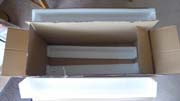
|
|
The case itself is sturdy and well made with strong
lockable catches, and comfortable carry handles (also one
each end not shown here). No problems there.
|
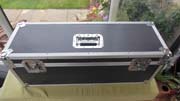
|
|
So what was inside? The telescope was well protected by
shaped foam. No finder or diagonal as expected, but space at
least for the small finder I intended to use. Because it
will (for me at any rate) always be on a GOTO mount, I
won't be star hopping so don't need a big finder scope.
|
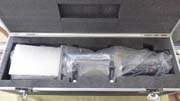
|
|
Out of the box with the focuser extended it's BIG! A
slightly shorter focal length at 910 mm than my venerable
Meade 127 which it replaces, so no longer, but thicker of
course, and the 4" focuser is massive - smooth and solid. A
very slight criticism. The substantial lens cap is not
screwed on, just a push fit. And as soon as I lifted the
telescope out of the box, the cap fell off. On to carpet
fortunately so no damage. A judicious application of extra
felt courtesy of hook and loop adhesive tape cured the
problem.
Later. Some of the adhesive from the extra felt got onto
the tube, spoiling the appearance, and the tighter cap was
tricky to fit. So I eventually removed the extra felt,
cleaned the tube and fitted a couple of plastic thumbscrews.
Problem solved, much easier and properly secure.
|

|
|
The beautiful 140 mm 5 1/2" objective lens. Slightly
green tinted coatings and minimal reflections. Looking
good!
|
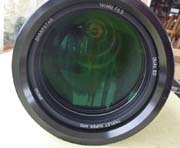
|
|
Because both my Observatory G41 and 'Star Party' EQ6
mounts have Vixen style dovetail clamps, the supplied
Losmandy style dovetail had to be replaced. I ordered a
solid 18 mm unit from FLO, knowing it wouldn't be long
enough, but intending to swap it with the even more sturdy
unit on my TMB 105. That was just long enough and there were
even tapped centre holes on the tube rings, so just a matter
of drilling one new hole in the dovetail and screwing firmly
on with socket cap screws.
|
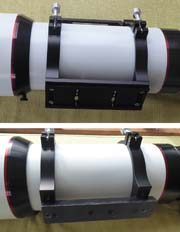
|
|
And here she is on my Observatory mount. Beautiful!
|
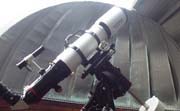
|
|
First Light Optics clearly have a sense of humour, with
this sticker on the outer box. It is a well known phenomenon
that new astronomical equipment boxes release magic clouds
when opened. And it was definitely the case with this one -
not only cloudy but foggy that first night. And the forecast
was poor for the next few nights before the Moon became
obtrusive again. So awaiting first light.
|
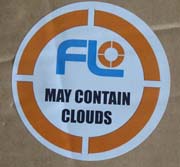
|
A little later on 2nd September. While waiting for a clear night
and first light (starlight anyway, daytime tests already carried out,
partly to align the finder scope), I decided it would be prudent to
try the telescope on my EQ6 mount prior to a forthcoming trip to the
Kelling Heath Star Party later in September. Hopefully no additional
balance weights would be needed.
|
When I installed the new focuser on my Meade
127 I made an adapter for the field flattener which
screwed onto the 63 mm focuser thread revealed when the push
fit unit was removed. The focuser on the Sharpstar has a
number of reducers, the smallest thread being 68 mm in
diameter. So I made a new adapter. Not absolutely essential,
but the 48 mm rear thread allows me to screw on the
flattener and camera, thereby ensuring that the camera is
square on to the telescope and of course secure.
|
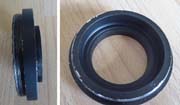
|
|
An added bonus of the big focuser is that it has two
rotators, one at the front and one at the rear. So with the
main rotator set to give a comfortable position for the
finder scope, the camera can be independently rotated. And
the 2" diagonal which has a 48 mm thread in the front can
also be screwed on. Of course whether the diagonal is push
fitted or screwed on, it can be easily rotated using the
rear focuser rotator.
|
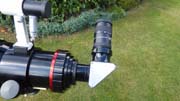
|
|
So here is the telescope with my QSI camera and Starlight
Xpress Active Optics unit fitted. In this case using the 2"
push fit clamp. Just balances with the standard weights.
This photo was taken with both axis clamps slack. As can
just be seen there is about 1/2" of movement left on the
balance bar. Phew!
|
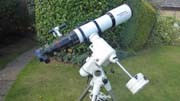
|
|
Final check is the camera and flattener fitted. Until I
do a star field test I don't know if the flattener will be
needed, but just in case... The camera and flattener unit
altogether weighs just under 2.5 Kg - quite a lump! But the
focuser copes with it comfortably including the fine focus
lifting it with ease. Still nicely balanced, and considering
that the substantial lens cap weighs 300 g, all is well.
|
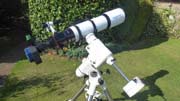
|
|
Here is the first deep sky image. Using the TS FLAT2
flattener successfully. Very poor sky conditions on 2nd
September with haze and cloud, so would hope for a much
better image in good conditions. QSI 683, Luminance and RGB
all 3 x 2 minutes unbinned. But a good start. Full
size
|
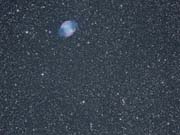
|
I was away on holiday for a week, returning on 12th September. And
for once the night was clear, steady and cloud free, so I was able to
do some more tests. Previously I had detected some astigmatism near
focus, but now found that it only appeared when I used my Hyperion
zoom eyepiece at maximum focal length of 24 mm. Zoom in to 8 mm and
all was well, indeed very well. And no problem at all with my 8 mm
Televue Radian. So it was all down to the eyepiece. Almost
unnoticeable fringing on the fully lit edge of the bright (92%) Moon.
Bright stars free of any chromatic aberration.
Intra and extra focal figures are almost identical. Not quite as
good as my superb TMB 105 but very close, and certainly most
acceptable. When Es Reid tested it he was very impressed, to quote
First Light Optics he "spoke about it in glowing terms". I'm looking
forward to many happy hours of use with this fine instrument.
For anyone reading this report, here are some later images to give
an idea of its capabilities, just click on the links:
Caroline's Rose (NGC
7789, Hickson 68 galaxy
cluster, Sharpless
115, for Lunar
observers












